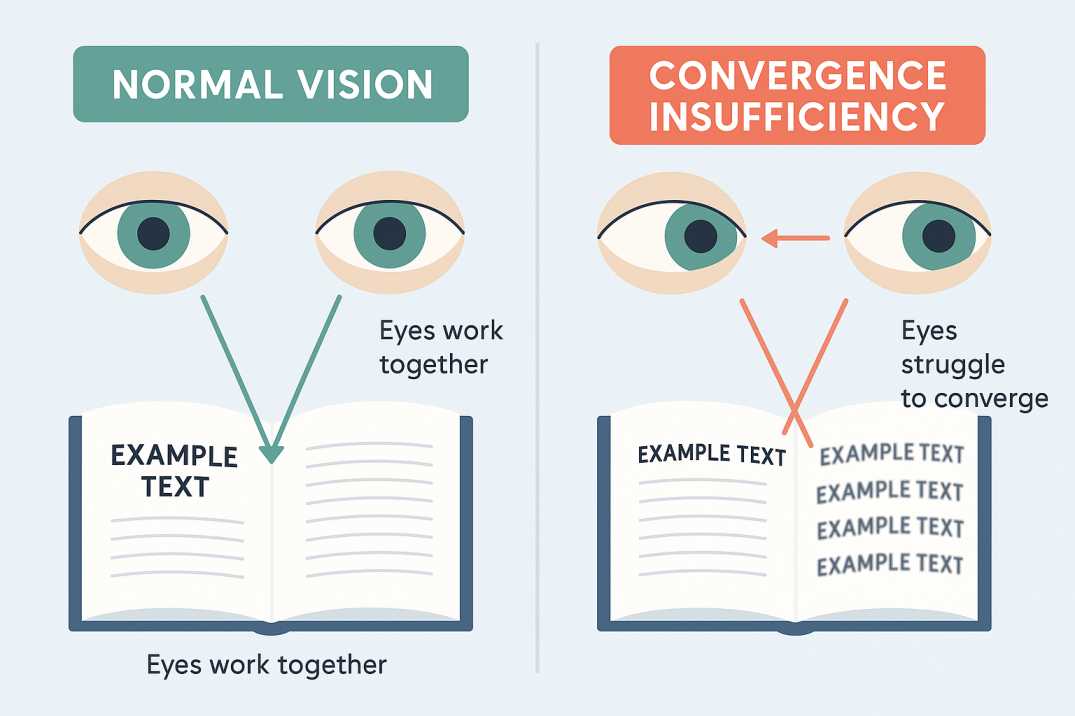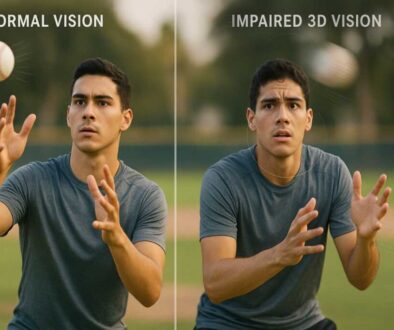Hidden Vision Problem Affecting School Performance

The Silent Struggle Millions Face Every Day
Imagine sitting down to read a book, only to watch the words blur together, jump around on the page, or suddenly appear doubled. Picture a bright child who struggles in school despite obvious intelligence, labeled as “lazy” or “inattentive” when the real culprit is hiding in plain sight. This is the daily reality for millions dealing with convergence insufficiency, a hidden vision problem that dramatically affects performance in school, work, and life.
Bottom Line Up Front: Convergence insufficiency (CI) affects up to 13% of children and 17% of adults, causing reading difficulties, headaches, and concentration problems that are often misdiagnosed as ADHD or learning disabilities. The good news? This condition responds excellently to specialized vision therapy, with 75% of patients achieving significant improvement within 12 weeks of proper treatment.
What Is Convergence Insufficiency?
Convergence insufficiency is a binocular vision disorder where your eyes struggle to work together when focusing on nearby objects. When you look at something close, like reading a book or using a smartphone, your eyes should naturally turn inward (converge) to create a single, clear image. With CI, one or both eyes have difficulty making this coordinated movement, leading to a cascade of visual and performance problems.
Think of your eyes as a well-choreographed dance team. Normally, they move in perfect synchronization to create a clear vision. With convergence insufficiency, it’s as if one dancer keeps missing their cues, creating chaos in what should be a seamless performance.
The Neurological Connection
The root of convergence insufficiency lies in communication breakdowns between your brain and the nerves controlling eye muscles. Your eye muscles themselves are typically healthy – the problem occurs when the neurological signals that coordinate eye movements fail to function properly. This explains why convergence insufficiency often develops after brain injuries, concussions, or periods of high visual stress.
The Hidden Epidemic: Who Does This Affect?
Research reveals staggering statistics about convergence insufficiency that most people never hear:
- 2% to 13% of children struggle with this condition, with most studies citing around 5% of school-aged students
- Approximately 7.5% of the general population experiences convergence insufficiency
- Up to 1 in 6 adults (approximately 17%) may have symptoms of convergence insufficiency
- 3-4 children in every classroom may be dealing with undiagnosed CI
- The condition affects more people than many well-known eye conditions
Perhaps most concerning is that convergence insufficiency often goes completely undetected. Standard vision screenings and routine eye exams frequently miss this condition because they focus on distance vision and basic eye health rather than how well the eyes work together for near tasks.
Recognizing the Warning Signs
Visual Symptoms That Disrupt Daily Life
Convergence insufficiency manifests through a variety of symptoms that significantly impact performance:
Reading and Near Work Difficulties:
- Words appearing to move, jump, or float on the page
- Frequent loss of place while reading
- Need to re-read passages multiple times
- Intermittent blurred or double vision
- Letters and words appear to flip or reverse
Physical Discomfort:
- Headaches, especially frontal or “behind the eyes”
- Eye strain and fatigue after short periods of near work
- Sore, uncomfortable, or tired eyes
- Pulling sensation around the eyes
Behavioral and Performance Impact:
- Avoiding reading or homework
- Taking frequent breaks during near tasks
- Covering or closing one eye while reading
- Poor concentration and attention span
- Inconsistent academic performance
The ADHD Connection: A Critical Misdiagnosis
One of the most significant challenges with convergence insufficiency is its frequent misdiagnosis as ADHD. Research has uncovered concerning connections:
- Children with CI show a higher prevalence of binocular vision problems when using proper diagnostic criteria
- 15.9% of children with ADHD also have convergence insufficiency
- Studies show a 3 times higher incidence of ADHD diagnoses among children with CI compared to the general population
- Over 75% of children with both conditions were on ADHD medication when CI was finally diagnosed
The overlap occurs because both conditions can cause difficulty with attention, concentration, and task completion. However, when the root cause is a vision problem, ADHD medications provide little relief for the underlying visual struggles.
Dr. David Cook, with over 40 years of specialized experience treating vision problems at Cook Vision Therapy Center, emphasizes: “We regularly see children who have been struggling with ADHD symptoms for years, only to discover that convergence insufficiency was the hidden culprit all along. Once we address the vision problem with proper therapy, many of these behavioral and attention issues resolve naturally.”
The Academic and Professional Performance Impact
Educational Consequences
For students, convergence insufficiency can be devastating to academic performance:
- 3 times more likely to be in the bottom 25% of their class
- Significant reading comprehension difficulties
- Reduced reading speed and efficiency
- Math problems due to difficulty aligning numbers
- Poor handwriting and copying from the board
- Decreased participation in classroom activities
Workplace Challenges
Adults with convergence insufficiency face their own set of professional hurdles:
- Computer work becomes exhausting and uncomfortable
- Difficulty with detailed paperwork and documentation
- Reduced productivity during tasks requiring sustained focus
- Increased errors in work requiring visual precision
- Fatigue that impacts overall job performance
The Science Behind Treatment: Research-Backed Solutions
Vision Therapy: The Gold Standard Treatment
Extensive research, including landmark studies funded by the National Eye Institute, has established vision therapy as the most effective treatment for convergence insufficiency. The Convergence Insufficiency Treatment Trial (CITT), one of the largest and most rigorous studies ever conducted on this condition, produced compelling results:
Treatment Outcomes from the CITT Studies:
- 75% of children achieved normal vision or significant symptom improvement with office-based vision therapy
- Only 43% improved with home-based pencil push-ups alone (no better than placebo)
- Near point of convergence improved 4 times more with vision therapy compared to simple exercises
- Positive fusional vergence increased significantly in the vision therapy group
- Long-term follow-up studies confirm that improvements are maintained at 1-year follow-up visits
How Vision Therapy Works
Vision therapy for convergence insufficiency involves a systematic program of exercises and activities designed to:
- Strengthen eye muscle coordination through targeted convergence exercises
- Retrain neurological pathways that control eye movements
- Improve visual processing and integration skills
- Develop sustained near vision abilities for reading and computer work
- Build automaticity in convergence responses
Treatment typically involves:
- Weekly office sessions with a trained vision therapist (45-60 minutes)
- Home reinforcement exercises (15 minutes, 5 days per week)
- Specialized equipment, including prisms, lenses, and computerized training tools
- Progress monitoring to ensure optimal treatment outcomes
Advanced Treatment Approaches
Modern vision therapy incorporates cutting-edge technology and techniques:
Computer-Based Training:
- Specialized software programs that precisely control convergence demands
- Real-time biofeedback to optimize training efficiency
- Gamified exercises that maintain patient engagement
Therapeutic Prisms:
- Temporary relief of symptoms during the therapy process
- Training tools to gradually build convergence strength
- Diagnostic aids to determine optimal treatment parameters
Brock String and Other Tools:
- Time-tested convergence training devices
- Accommodative rock exercises to improve focusing flexibility
- Stereoscopic exercises to enhance depth perception
Debunking Common Myths and Misconceptions
Myth 1: “My Child Has 20/20 Vision, So They Can’t Have a Vision Problem”
Reality: Convergence insufficiency is completely separate from visual acuity. Children can pass standard eye charts with flying colors while struggling significantly with near vision tasks. The 20/20 eye chart tests distance vision only and misses the majority of functional vision problems.
Myth 2: “Pencil Push-Ups Are Just as Effective as Professional Treatment”
Reality: Research clearly demonstrates that home-based pencil push-ups alone are insufficient for treating convergence insufficiency. While these exercises can provide some benefit when combined with professional therapy, they achieve only 43% success rates compared to 75% with comprehensive office-based treatment.
Myth 3: “Children Will Outgrow This Condition”
Reality: Convergence insufficiency does not improve on its own. Without proper treatment, the condition persists into adulthood, continuing to impact reading, work performance, and quality of life. Early intervention provides the best outcomes.
Myth 4: “Surgery Is Necessary for Severe Cases”
Reality: Surgery is rarely needed for convergence insufficiency. Vision therapy successfully treats even severe cases without surgical intervention. Surgery is typically reserved only for cases with significant eye turns that don’t respond to therapy.
The Diagnostic Process: Getting Accurate Answers
Comprehensive Vision Examination
Diagnosing convergence insufficiency requires specialized testing that goes far beyond routine eye exams:
Key Diagnostic Tests:
- Near Point of Convergence (NPC): Measures the closest distance eyes can maintain single vision
- Positive Fusional Vergence: Tests the strength of convergence muscles
- Phoria Testing: Evaluates eye alignment at rest
- Accommodation Assessment: Examines focusing abilities
- Symptom Survey: Standardized questionnaires to quantify functional impact
When to Seek Professional Evaluation
Consider a comprehensive vision evaluation if you or your child experiences:
- Difficulty with reading comprehension or speed
- Frequent headaches during near work
- Double vision or words appearing to move
- Avoidance of reading or homework
- Poor concentration during visual tasks
- ADHD-like symptoms that don’t respond to typical interventions
Dr. Cook emphasizes the importance of finding the right professional: “Not all eye care providers are trained to diagnose and treat convergence insufficiency. Families should seek out optometrists who specialize in binocular vision disorders and vision therapy.”
Treatment Timeline and Success Factors
What to Expect During Treatment
Initial Phase (Weeks 1-4):
- Comprehensive evaluation and treatment planning
- Introduction to basic convergence exercises
- Establishing home exercise routines
- Initial symptom monitoring
Development Phase (Weeks 5-8):
- Progressive increase in exercise difficulty
- Integration of accommodative and vergence training
- Fine-tuning of treatment parameters
- Noticeable symptom improvements typically begin
Mastery Phase (Weeks 9-12):
- Advanced exercise protocols
- Real-world application training
- Preparation for treatment graduation
- Sustained improvement in daily activities
Factors That Influence Success
Several factors can impact treatment outcomes:
Positive Factors:
- Early intervention and accurate diagnosis
- Consistent attendance at therapy sessions
- Regular completion of home exercises
- Family support and understanding
- Absence of other underlying conditions
Challenging Factors:
- Delayed diagnosis after years of struggle
- Inconsistent therapy attendance
- Concurrent learning disabilities or ADHD
- High visual demands without adequate breaks
- Stress or fatigue that exacerbates symptoms
The Life-Changing Impact of Treatment
Academic Transformation
Students who receive proper treatment for convergence insufficiency often experience dramatic improvements:
- Reading speed increases of 50-100% or more
- Comprehension improvements that unlock academic potential
- Reduced homework time due to increased efficiency
- Improved test performance in all subject areas
- Enhanced self-confidence and love of learning
Professional and Personal Benefits
Adults who address their convergence insufficiency report:
- Increased work productivity and reduced fatigue
- Improved computer comfort for extended periods
- Enhanced quality of life through better visual function
- Reduced headaches and eye strain
- Greater enjoyment of reading and visual activities
Prevention and Maintenance Strategies
Protecting Your Vision in the Digital Age
While convergence insufficiency often has neurological roots that can’t be prevented, certain strategies can reduce risk and maintain healthy vision:
Digital Device Guidelines:
- Follow the 20-20-20 rule: Every 20 minutes, look at something 20 feet away for 20 seconds
- Maintain proper reading distances (16-24 inches from books/screens)
- Ensure adequate lighting for near work
- Take regular breaks during extended visual tasks
Lifestyle Factors:
- Maintain regular sleep schedules to prevent visual fatigue
- Stay hydrated to support optimal eye function
- Manage stress levels that can exacerbate symptoms
- Include regular physical activity to support overall health
Long-Term Maintenance
After successful treatment, most patients maintain their improvements through:
- Regular use of visual skills through reading and near work
- Periodic reinforcement exercises if symptoms resurface
- Annual check-ups with vision therapy specialists
- Prompt attention to any recurring symptoms
Cook Vision Therapy Center: Your Partner in Vision Health
At Cook Vision Therapy Center, we understand the profound impact that convergence insufficiency can have on every aspect of life. With Dr. David Cook’s four decades of specialized experience and Dr. Ekta Patel’s advanced training in vision therapy, our team provides the expertise and compassion needed to transform lives through better vision.
Our Specialized Approach
Comprehensive Evaluation: We conduct thorough assessments that go far beyond routine eye exams, utilizing advanced diagnostic equipment and standardized testing protocols to accurately identify convergence insufficiency and related conditions.
Personalized Treatment Plans: Every patient receives an individualized therapy program designed specifically for their unique needs, lifestyle, and goals.
Family-Centered Care: We understand that vision problems affect the entire family. Our team provides education, support, and guidance throughout the treatment journey.
Proven Results: Our track record speaks for itself, with thousands of successful patients who have overcome the challenges of convergence insufficiency and related vision problems.
References and Resources
The information in this article is based on peer-reviewed research and clinical studies. Here are the key sources that informed our comprehensive analysis:
Primary Research Studies:
1. Convergence Insufficiency Treatment Trial (CITT) – National Eye Institute
- Multiple randomized clinical trials demonstrate a 75% success rate with office-based vision therapy
- Published in Archives of Ophthalmology and Optometry & Vision Science
- Key Finding: Office-based therapy with home reinforcement is significantly more effective than pencil push-ups alone
- National Eye Institute – Convergence Insufficiency
2. Convergence Insufficiency Treatment Trial – Attention and Reading Trial (CITT-ART)
- 2019-2024 studies on reading performance and long-term outcomes
- Morrison AM, et al. Ophthalmic Physiol Opt. 2024 Nov;44(7):1346-1353
- Key Finding: Vision therapy effectively improves convergence, but reading gains require additional intervention
- PubMed Study Link
3. ADHD and Convergence Insufficiency Connection Research
- Granet DB, et al. Strabismus. 2005;13:163-168
- Recent 2024-2025 studies on prevalence in ADHD populations
- Key Finding: 15.9% of children with ADHD also have convergence insufficiency; 3x higher diagnosis rate
- Research on ADHD-CI Connection
Additional Clinical Resources:
4. StatPearls Medical Reference – Convergence Insufficiency
- Comprehensive medical overview updated 2023-2025
- Prevalence data: 2-13% in children, 7.5 in % general population
- StatPearls – NCBI Bookshelf
5. Cochrane Systematic Review – Interventions for Convergence Insufficiency
- 2020 meta-analysis of treatment effectiveness
- Network analysis of multiple treatment approaches
- Cochrane Database Systematic Review
6. Recent Prevalence Studies (2022-2025)
- Spanish school children study – Journal of Optometry 2022
- Post-concussion CI prevalence – Brain Injury 2024
- Updated epidemiological data on convergence insufficiency
Taking the Next Step
If you recognize the signs of convergence insufficiency in yourself or your child, don’t wait for the problem to resolve on its own. Early intervention provides the best outcomes and can prevent years of unnecessary struggle.
Red Flags That Require Immediate Attention:
- A child who was previously a good reader suddenly struggles
- Persistent headaches during or after visual tasks
- Avoidance of reading or homework
- Double vision or words appearing to move
- Concentration difficulties that don’t respond to typical interventions
The Path Forward
Recovery from convergence insufficiency is not just possible – it’s highly probable with proper treatment. The research is clear, the techniques are proven, and the outcomes are life-changing. Don’t let this hidden vision problem continue to hold you or your loved ones back from reaching full potential.
Contact Cook Vision Therapy Center today to schedule a comprehensive evaluation. Our team is ready to help you discover whether convergence insufficiency might be the missing piece in your educational, professional, or personal challenges.
Remember: You don’t have to live with the frustration and limitations of convergence insufficiency. Expert help is available, and transformation is within reach.
Ready to take control of your vision and unlock your full potential? Contact Cook Vision Therapy Center to schedule your comprehensive vision evaluation today. Our Marietta location serves families throughout Metro Atlanta with the specialized care you deserve.
FAQs
-
Convergence insufficiency is a vision disorder where your eyes struggle to turn inward together when focusing on nearby objects like books or screens, causing eye strain, headaches, blurred vision, and difficulty reading.




